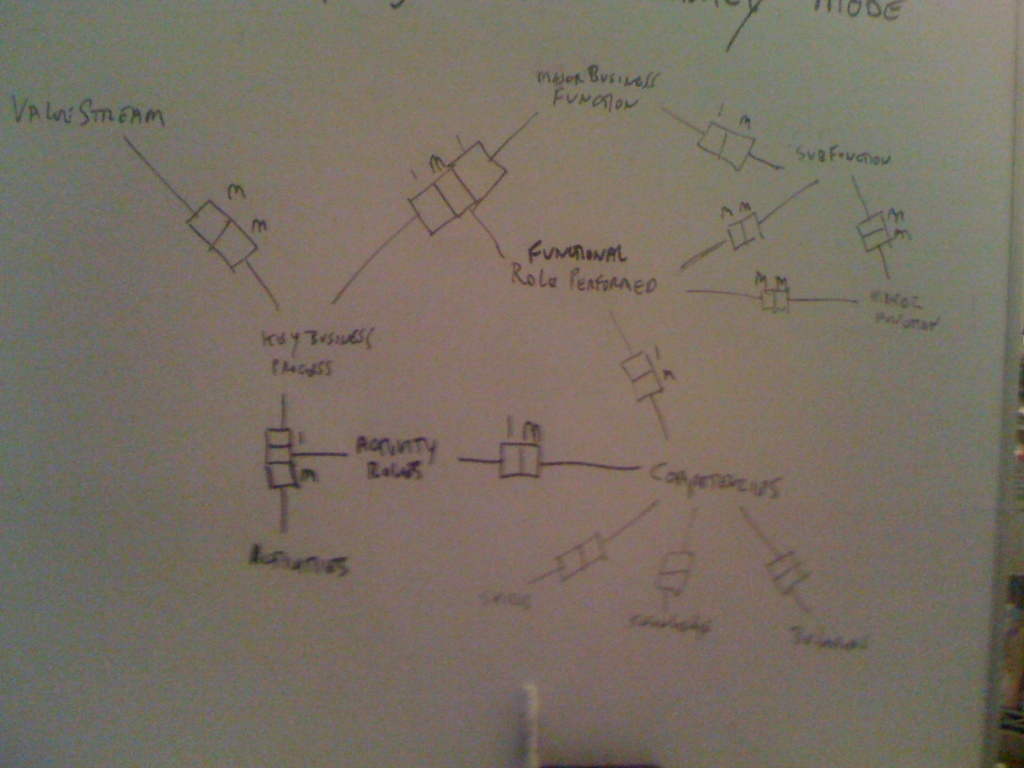One of the interesting this about taxonomy work is that it exposes value systems and mental models of the participants. Take for instance a simple organizational design and development project. Various terms are thrown around in a casual manner and have different meanings depending upon your background. The term Business Function has been used to mean the activity or action taken within an company –this could be a synonym for process—or the association of people with a common purpose and management, commonly called groups, divisions, or departments (e.g, HR Department). While the term or label used often infers a result that both definitions produces, when working to define taxonomy this ambiguity and automatic context shifting people do unconsciously results in serious nightmares for information systems.
Above is a simple data model of an enterprise I’m working on today. The goal is to define a model of how an organization functions. There are many models out there; Value Chain (Porter), Value Net (Slywotzky), Division (Sloan) and Generic Enterprise (McKinsey) to name a few. These models all create taxonomies in which to classify and place instances of a working company’s structure into a framework for thinking. However, the ontology beneath these taxonomies is often hidden. Thus without the context of the authors the terms definitions diffuse into ambiguity eventually becoming overloaded and creating chaos. Did you mean the activity or the group of people when I say function? Information Systems are not smart enough yet to ask programmers or end users what you mean by that term.
While this sounds like a fairly esoteric and academic issue, I assure you it’s not. The project is real. The various companies and stakeholders are trying to decide how to restructure to gain competitive advantage or at the least gain efficiencies to capitalize of new opportunities on the horizon. Without a common framework to organize around companies become misaligned and operate very poorly. In not the worst case scenarios, departments work at cross purposes or even counter to each other. In the 80s I watched two divisions literally undo each other’s work RIGHT IN FRONT OF THE CUSTOMER. It was painful to watch from a professional organization. When I debrief both organization heads both were positive they were following the company’s direction.
The next step in this activity would be to associate processes, capabilities, and other resources to these functions. However, the context switch between activities vs. management structure (org-charts) models that the prior are based upon results in many misalignments and wicked programs. If a Business Function is a people association structures at which decomposition layer into smaller units to you assign roles which is the linkage between key processes, the value stream and competencies needed to perform these activities within the “function”. Add to this mixture that multiple functions and multiple competencies participate all participate in multiple value streams and processes, it become a web of complexity quickly.
Again while it sounds fairly esoteric I had to be brought in to straighten out this issue when one corporation decided to implement another’s process. They wanted to keep how the company was structured but they also wanted to use the process. It took several months to be able to rationalize the differences in terms and frameworks for the corporation to successfully deploy the process. The alternative was to turn the corporation inside out to match the model the processes and software had. The choice to rationalize vs. change organizational structures was one of find the least objectionable alternative.
–all this is neded to resolved before you could place the taxonomy into SharePoint’s Term Store for publication to various farms





Leave a Reply
You must be logged in to post a comment.